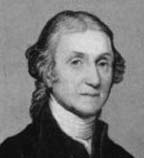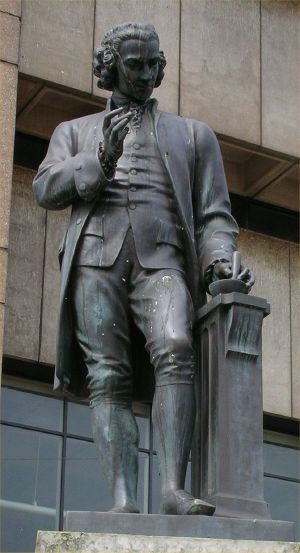Joseph Priestley

<<Please remove all square brackets enclosing dates and names of places, except names of nations.>>
Joseph Priestley (March 13, 1733 – February 8, 1804) was an English chemist, philosopher, dissenting clergyman, and educator.[1]
He is known for his investigations of carbon dioxide and the co-discovery of oxygen.
Early life and education
He was born in Birstall parish, six miles from Leeds, Yorkshire. He learned a variety of languages, both classical and modern, in his youth, including several Semitic languages. He also studied what was then known as natural history. The school he attended, Batley Grammar School, still exists, and it now has a junior and infants section for children between the ages of 2-10 named Priestley House.
In 1751 he entered Daventry, a school under the auspices of Nonconformism, and there his religious views took shape. He became an adherent of Arianism and a fervent abolitionist. In September, 1755, he started as a parish minister in Needham Market, Suffolk, though he was not officially ordained until 18 May, 1762.
Because he stammered, and the parish was neither suited to his heterodox ideas, nor wanting a bachelor for their minister, Priestley was unpopular in his Suffolk parish and ultimately went to Nantwich, Cheshire. He established a private school in connection with the church in Nantwich where he preached, and derived his income from that school.
Warrington
Subsequently he went to Warrington Academy, the biggest of the dissenting academies in England, as a tutor in belles-lettres. By this time his religious ideas had matured to Socinianism, a form of Unitarianism. At Warrington, he associated with other liberal-minded tutors. A sympathetic printer, William Eyres, was willing to publish his work. It was here that he published his grammar book in 1761 (a remarkably liberal grammar for its day) and other books on history and educational theory. He taught anatomy and astronomy and led field trips for his students to collect fossils and botanical specimens. Both modern history and the sciences were subjects which had not been taught in any schools before Priestley.
Leeds
On 23 June 1762, Priestley married Mary Wilkinson of Wrexham, and by September 1767 the combination of his finances and her health caused him to relocate to Leeds. He there took charge of the Mill Hill congregation. In Leeds Priestley also published two political works, Essay on the First Principles of Government (1768) and The Present State of Liberty in Great Britain and her Colonies (1769). In 1769 followed Remarks on Dr. Blackstone's Commentaries, where he defended constitutional rights of dissenters against William Blackstone.
Priestley's house was next to a brewery and Priestley began to experiment with the gas given off by fermenting beer. His first experiments involved demonstrating that the gas would extinguish lighted wood chips. He then noticed that the gas appeared to be heavier than normal air as it remained in the vats and did not mix with the air in the room. The gas, which Priestley called "fixed air" and had already been discovered and named "mephitic air" by Joseph Black, was carbon dioxide. Priestley discovered a method of impregnating water with the carbon dioxide by placing a bowl of water above a vat of fermenting beer. The carbon dioxide soon became dissolved in the water (producing soda water) and Priestley found that the impregnated water developed a pleasant sweet acidic taste.
He began to offer the treated water to friends as a refreshing drink. In 1772 Priestley published a paper entitled Impregnating Water with Fixed Air in which he described a process of dripping sulfuric acid (or oil of vitriol as Priestley knew it) onto chalk in order to produce carbon dioxide and forcing the gas to dissolve by agitating a bowl of water in contact with the gas. In December, 1772, at the instigation of Benjamin Franklin, Priestley was hired by Lord Shelburne, as his personal librarian, and stayed in that post until 1780.
In 1772 Priestley wrote Observations on Civil Liberty and the Nature and Justice of the War with America. Whilst tutoring his benefactor's sons at Bowood House near Calne in 1774 he discovered oxygen, unaware of Carl Wilhelm Scheele's prior discovery sometime before 1773. Priestley's discovery was published in 1775 in Experiments and Observations on Different Kinds of Air and in 1777 Scheele's discovery was published in his book Chemical Treatise on Air and Fire.
Both Priestley and Scheele were unaware that oxygen was a chemical element; Priestley named the gas (which he had generated by heating red mercuric oxide with a "burning lens") "de-phlogisticated air", in accordance with the phlogiston theory which held at the time. Priestley's concept of the gas which so delightfully supported and enhanced combustion was shaped by his attachment to the prevalent "phlogiston theory." According to that theory, a burning material releases an invisible, weightless substance called phlogiston. Observations of the results of burning by Priestley and others showed that the net weight of the products remaining after combustion was greater than that of the original materials before the chemical reaction. An awkward explanation was offered that somehow a substance (phlogiston)with "negative weight" was released during the burning process and the surrounding air (or gas) needs to have the capacity to absorb this phlogiston. Priestley found that the gas he discovered could support combustion for longer than ordinary air. He surmised that this gas contained no phlogiston and could absorb more of it than could ordinary air. He therefore called the gas dephlogisticated air.
<<Please add a short explanation of "phlogiston theory" and what Priestley meant by "de-phlogisticated air". You can consult our article on Oxygen and Wikipedia's article on phlogiston theory.>>
In 1777, he wrote The Doctrine of Philosophical Necessity. This book was devoted to the subject of the freedom of the human will. Schopenhauer, in his On the Freedom of the Will, in 1839, included Priestley as one of three great men who completely changed their minds regarding this subject. "This proves," he wrote, "how difficult and deep down is the correct insight into our problem." The other two great men, Schopenhauer wrote, were Spinoza and Voltaire. Priestley wrote that "There is no absurdity more glaring to my understanding, than the notion of philosophical liberty. — Without a miracle, or the intervention of some foreign cause, no volition or action of any man could have been otherwise, than it has been."
There is a statue of Priestley in Leeds City Square.
Birmingham
In 1780 he moved to Birmingham and was appointed junior minister of the New Meeting Society. He became a member of the Lunar Society, but his admiration for the French Revolution caused him to be driven out of the city in the Priestley Riots of 1791. He is remembered there by the Moonstones, and a more traditional statue in Chamberlain Square in the city centre. The latter is a 1951 recast, in bronze, of a white marble original by A. W. Williamson, unveiled in 1874.
There is a Blue Plaque comemorating him on on the side of the Church of St Michael and St Joseph, New Meeting House Lane, Birmingham [1], and another on the Warrington Salvation Army Citadel, once the home of Priestley[2].
London and USA
He next moved to London where he received an invitation to become morning preacher at Gravel Pit Chapel, Hackney. His three sons emigrated to the United States in 1793. The following June, Priestley followed them, seeking political and religious freedom. Although never naturalised, he lived in Northumberland, Pennsylvania, for the last decade of his life until his death at the age of 70. Priestley is buried in rural Northumberland, Pennsylvania.
Honors and extras
- The American Chemical Society's highest honour, the Priestley Medal, is named for him.
- Priestley College in Warrington is a sixth form college (for 16–19 year olds) named in his honour. It is the largest sixth form college in Warrington, and within its main building, a statue of Joseph Priestley stands, watching over the students as they pass through the reception area.
- The writer Hilaire Belloc was Priestley's great-grandson.
See also
Footnotes
<<The following is a sample footnote. Actual footnotes will appear once created within the text of the article. Please retain the coding "references /" below.>>
- ↑ This is a sample footnote.
ReferencesISBN links support NWE through referral fees
<<Please add at least 3 good references here. The references may be books and/or Web sites, but they need to be formatted according to the style given in our Writer's Manual.>>
External links
- The Joseph Priestley Society
- A comprehensive Biography at the Woodrow Wilson National Fellowship Foundation
- A detailed biographical article from the Thoemmes Dictionary of Eighteenth-Century British Philosophers.
- Priestley Sixth Form College, Warrington, named for Joseph Priestley
- Priestley artifacts on display at "Revolutionary Players" industrial revolution website, URL accessed August 14, 2006
- Joseph Priestly Biography, part of a series of famous American Unitarians.
Credits
New World Encyclopedia writers and editors rewrote and completed the Wikipedia article in accordance with New World Encyclopedia standards. This article abides by terms of the Creative Commons CC-by-sa 3.0 License (CC-by-sa), which may be used and disseminated with proper attribution. Credit is due under the terms of this license that can reference both the New World Encyclopedia contributors and the selfless volunteer contributors of the Wikimedia Foundation. To cite this article click here for a list of acceptable citing formats.The history of earlier contributions by wikipedians is accessible to researchers here:
The history of this article since it was imported to New World Encyclopedia:
Note: Some restrictions may apply to use of individual images which are separately licensed.
